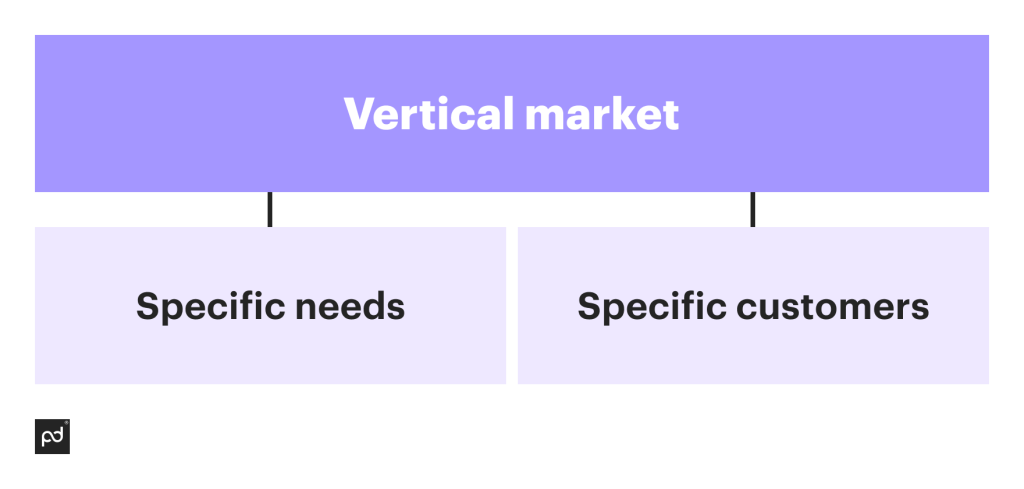Let’s say you’re the head of sales in a small company that recently launched a product.
Your task as a sales manager is to market it.
Your product is of service to the widest range of potential customers.
But appealing to large audiences doesn’t help your business to reach sales goals, or generate and convert enough leads.
Company management is concerned about the loss of money spent on a failed attempt to fulfill the existing sales strategy and now has to be extremely careful about strategizing.
So, how can you operate with lower capacity yet higher efficiency within this context?
The answer is “by implementing a vertical marketing strategy.” Targeting specific audiences with specific needs and interests will bring you a chance to:
- take enough time to get to know the industry or customer group better;
- become an expert in the selected industry or niche your product serves;
- eventually acquire loyal customers and form a community around your product;
- broaden your product line and target more verticals later with the company’s evolution.
In this article, we’ll explore why pivoting toward a vertical market approach, both as a model for small and medium-sized businesses and as a framework for sales and marketing campaigns, can help your team achieve outperformance.
So, off we go!
Key takeaways
- Targeting specific, niche markets with specialized products and services can help small businesses operate more efficiently with lower costs and higher revenue. This is known as vertical marketing.
- The benefits of a vertical marketing strategy for SMBs include focusing resources effectively, developing expertise, fostering innovation, commanding premium prices, and laying the foundation for future growth. The drawbacks include a limited customer base, dependence on a single industry’s performance, and lack of diversification.
- Implementing a vertical strategy involves identifying target vertical markets by analyzing your customer base, researching industry trends, identifying pain points, evaluating market fit, and monitoring industry developments.
- Sales and marketing teams require skills like industry knowledge, targeted market research, persona development, niche-specific content marketing, networking, collaboration, and data-driven decision-making.
- Best practices for vertical sales and marketing include targeted advertising, content marketing, participating in industry events, establishing thought leadership, social media marketing, direct outreach, referral programs, industry partnerships, cross-selling, upselling, SEO, and CRM.
What is vertical marketing?
First and foremost, let’s define what this vertical market thing means.
It may be confused with vertical integration, which is an economic term that refers to the practice of reducing operational costs by producing everything in-house instead of outsourcing from vendors.
A vertical market is a set of suppliers and their customers, focused on a specific and narrow niche, industry, or specialized market spanning multiple industries.
As you can see, a vertical market is fully about market segmentation.
There are multiple levels of market segmentation a business can find itself in — geography-wise, demographic-wise, psychographic-wise, behavior-wise, and industry-wise.
A basic characteristic of the vertical market is the existence of a specific customer segment with specific needs.

The segmentation refers to the terms ”sector,” “industry,” and “niche.”
These are related concepts yet not the same. Here’s how they differ in the hierarchy from the broadest to the narrowest:
- A sector is a large segment of the economy that contains industries
- An industry, similarly to a sector, is also broad yet represents a more specific group of companies that are engaged in similar business activities, produce similar products or provide similar services.
- A niche is a narrower segment of an industry that refers to a specific audience with a specific set of needs that a business aims to serve.
For instance, within the technology sector, there is a software development industry, which includes a veterinary software solutions niche.
Once we’ve realized what a vertical market is, we can broaden this knowledge by considering related and opposite concepts.
Vertical vs. multi-vertical vs. horizontal markets
Apart from vertical marketing, some businesses might span multiple industries or niches, i.e. different verticals, meaning they target multiple vertical markets.
And there is also an opposite approach to focusing on horizontal sales and marketing. Let’s stack these three concepts up.
- Vertical businesses focus on a single specific industry and niche, whereas a multi-vertical approach represents targeting several separate industries and niches (or several niches within a single industry). Lastly, a horizontal business mindset is aimed at a wide range of industries or customer segments.
- Both vertical and multi-vertical businesses provide tailored products or services designed to address the unique needs and requirements of specific industries or customer segments. The horizontal company offers generic products or services aimed at a wide audience.
- The value proposition of vertical and multi-vertical businesses is based on the specific needs of relevant audience segments, whereas for horizontal businesses it is always generalized.
- Horizontal businesses usually focus on specific functions which are common across different industries, while vertical and multi-vertical ones offer features that are highly specific to the niches they serve.
Pros and cons of vertical marketing and sales strategy for SMBs
Recent market dynamics indicate that businesses tend to increase their investments in vertical marketing strategy and tailoring their products to specific industries and niches.
For example, the Vertical Market Software Market report by Future Market Insights shows that the global market size of the vertical market software will rise from $122.2 billion in 2022 to $402.4 billion in 2032, with a CAGR of 12.6% year-over-year.

Let’s review the advantages and disadvantages of this approach.
Sales verticals advantages
Perfect to start with
Emerging and growing small businesses often have limited resources to address the needs of everyone.
A business can target a specific vertical market to concentrate its efforts and resources on understanding the unique needs and challenges of one particular industry.
This focus allows a business to develop specialized solutions and tailor offerings to meet the specific demands of the vertical market it aims to conquer.
A tool to scale up
Targeting vertical markets can be beneficial for further developing a small or midsize business into a bigger one.
A way to develop high expertise within an industry or niche
Vertically-focused businesses can develop a deeper understanding of the industry and its dynamics.
This expertise enables them to identify emerging trends, anticipate market shifts, and proactively adapt their offerings.
Such industry insights can provide a competitive advantage over businesses operating in horizontal markets.
Additionally, being immersed in the industry allows small businesses to stay updated on emerging trends and technologies, fostering innovation and keeping ahead of the competition.
Innovation-friendly approach
Specialized focus on vertical markets fosters product development and innovation.
Businesses that target a vertical market might gain an opportunity to occupy a niche that no one else can yet possess, operating with a unique technology or expertise nobody else has acquired at the given time.
Delivers higher value
Vertical market customers often perceive specialized solutions as having higher value compared to generic offerings.
They recognize that businesses catering specifically to their industry possess a better understanding of their challenges and can provide tailored solutions.
This perception can lead to a willingness to pay premium prices for specialized products or services.
Sales verticals disadvantages
Limited customer base
By focusing on a specific industry or niche, a business may have a smaller identified customer base compared to targeting a broader market.
This limited customer pool can possibly restrict your growth opportunities and revenue potential.
Dependent on industry performance due to a lack of diversification
When targeting a vertical market, a business becomes more susceptible to the ups and downs of that particular industry.
Economic downturns or shifts in industry dynamics can have a significant impact on the business, making it more vulnerable to market fluctuations.
Resource constraints
Developing industry-specific solutions and expertise can require significant investment in research, development, and specialized resources.
This can pose challenges for small businesses with limited budgets and resources, making it more difficult to penetrate and establish a strong presence in vertical markets.
Implementing a vertical sales and marketing strategy
As we’ve already highlighted, business verticalization involves aligning products, services, and resources to cater to the specific needs and demands of the chosen customer groups.
Vertical marketing strategy can help businesses reach their target market, close more sales, increase sales and profits, build reputation, and differentiate themselves from their competitors.
A recent McKinsey study of mobile SaaS startups found that 47% of those that focused on vertical markets had an average revenue per app installed of more than $500, compared with just 15% of horizontally-focused startups.
Next, let’s explore how to implement sales verticals & niche marketing in your business.
Some specifics of vertical sales and marketing implementation
Overall, there are 4 levels of market segmentation in the target marketing process:
- Mass marketing;
- Product-variety marketing;
- Vertical marketing (or niche marketing);
- Micro marketing (or account-based marketing, or ABM).
Vertical marketing, also known as niche marketing, industry-specific marketing, or concentrated marketing, refers to tailoring marketing efforts to reach a specific target audience (customer segment) more efficiently.
This includes creating industry-specific messaging and strategies that resonate with that specific customer group.
So, vertical marketing strategies are much more specific than mass marketing and not as custom as ABM.
The main characteristics of vertical marketing include:
- The presence of a targeted customer segment with a unique set of needs;
- Specific marketing efforts and activities within the industry or niche;
- Specific skills and competencies compared to those needed in the horizontal market;
- Premium prices for higher quality and specialized niche services.
Skills and competencies of vertical sales and marketing teams
Sales and marketing professionals should have some particular skills to succeed in vertical markets.
Industry-specific knowledge
Industry-specific knowledge includes an understanding of industry-wide terms and their definitions, dynamics, trends, regulations, and challenges.
The ability to speak the same language as the niche audience helps build credibility and trust.
Targeted market research
Targeted market research means extensive research and analysis of the target audience within the niche to identify their specific needs, preferences, behaviors, and pain points.
Customer persona development
Customer persona development is aimed at creating accurate and detailed customer personas beyond basic demographic information and developing comprehensive profiles that include psychographic characteristics, buying behaviors, motivations, and challenges to craft targeted messages and personalized marketing campaigns.
Niche-specific messaging, positioning, and content creation skills
Advanced content creation skills create compelling messages that resonate with the niche audience, directly address their pain points and communicate the UVP and its benefits.
This involves utilizing industry-specific language, examples, and case studies.
The solution-oriented approach
The solution-oriented approach includes showcasing expertise, understanding industry pain points, and demonstrating how the products or services can drive tangible results for customers.
Relationship building and networking
This group of skills includes building strong relationships with customers, establishing connections and partnerships with key stakeholders, engaging with the intended audience, establishing valuable connections at trade shows and conferences, as well as keeping up with online communities relevant to the vertical market industry.
Collaboration skills
Collaboration skills mean an ability to set up efficient collaboration between sales and marketing teams, as well as other internal departments to align strategies, share industry insights, and ensure consistent messaging and branding.
Digital marketing expertise
Proficiency in digital marketing strategies and tools — including SEO knowledge, social media marketing, content marketing, email marketing, and other relevant digital channels — is highly important for getting success in vertical markets.
Niche-specific channel identification
An ability to identify the most efficient communication channels to reach the target audience to maximize the reach and engagement within the vertical market.
Analytical and data-driven mindset
This is the ability to analyze data, track performance, and make data-driven decisions, including working with analytics tools and interpreting data to measure the success of marketing campaigns, identify opportunities, and optimize strategies for better results.
How to identify and target vertical markets
To determine the best vertical markets for targeting opportunities, include the following activities in your sales and marketing processes.
Analyze your existing customer base
Research your customer base and the potential market size that your business can serve. For instance, categorizing your customers by identifying:
- common characteristics in terms of industry, revenue, size, location, or other relevant factors;
- those most receptive to your sales efforts;
- those most manageable and ones you’ll be able to serve effectively.
Another level of research lies in identifying your customer segments’ preferences, such as:
- topics they search for the most;
- messaging that resonates with their interests and needs;
- channels they are actively engaged in;
- the content formats they are most responsive to.
Research industry trends
Channels where you could gain industry-specific data and insights may include:
- data on industry growth rates, market size, and emerging technologies;
- consumer behavior, purchasing patterns, and market shifts within the industry (including the data from analytical tools);
- surveys and interviews with customers and prospects within the target industry;
- technological advancements and their potential impact on the industry;
- competing products, their pricing strategies, and market positioning;
- industry news and publications;
- industry reports and market researches;
- industry-specific blogs, forums, and social media groups;
- industry conferences, trade shows, and webinars;
- information gained through networking with industry experts, engaging with industry associations and organizations;
- information gained through interviewing thought leaders and key stakeholders;
- regulatory changes and policy developments that impact the industry.
Look for industries that are experiencing growth, have specific needs or challenges that your offerings can address, or are aligned with your expertise and capabilities.
Conduct market analysis
Perform a comprehensive market analysis to assess the size, potential, and competitive landscape of various industries.
Evaluate factors such as market demand, customer preferences, industry regulations, and the presence of competitors. For instance, by:
- researching and collecting data on industry size, market trends, and growth potential;
- assessing pricing strategies and market positioning of competitors;
- analyzing customer demographics and psychographics to understand their preferences and behavior;
- identifying market opportunities and potential gaps in the industry;
- evaluating distribution channels and assessing the most effective channels to reach the target market;
- analyzing macroeconomic factors that may influence the industry, such as economic conditions and consumer spending;
- assessing the competitive landscape, including market share, strengths, and weaknesses of key players;
- summarizing findings and insights from the market analysis to inform strategic decision-making and marketing efforts.
Identify pain points of your TA
Focus on the pain points or challenges faced by businesses in different industries.
Consider how your products or services can provide unique solutions or value propositions to address those pain points efficiently.
Assess market fit
Evaluate the fit between your offerings and the needs of the target vertical markets.
Consider factors such as product compatibility, customization requirements, scalability, and the ability to meet industry-specific standards or regulations.
Receive feedback and insights
Engage with current customers, industry experts, and stakeholders to gather insights and feedback on potential vertical markets.
Their perspectives can provide valuable guidance and help you identify untapped opportunities.
For instance, you could use PandaDoc’s free product survey form to start.
Consider specialized features or benefits
Determine the extent of how much your products or services have unique features or benefits that make them particularly suited for specific industries or market segments.
This can be a strong indication of potential vertical markets to target.
Evaluate the competitive landscape
Assess the competition within each vertical market you are considering.
Evaluate the number and strength of competitors, their offerings, market share, and the level of saturation.
Identify areas where you can differentiate yourself and carve out a niche.
Conduct pilot programs
Consider running pilot programs or tests within selected vertical markets to assess the feasibility and potential success of your offerings.
Gather feedback, measure results, and make informed decisions based on the outcomes.
Continuously monitor and refine
Once you have identified and then entered specific vertical markets, continuously monitor market dynamics, customer feedback, and industry trends.
Adjust your sales strategies and tactics accordingly to stay competitive and capitalize on emerging opportunities.
Achieving premium pricing
Providing premium products or services implies that businesses offering unique, high-quality, and specialized services have the ability to charge commensurate premium prices for their offerings.
Your pricing strategy can be based on:
- pricing dynamics within the niche market (raise prices when the demand grows);
- unique value proposition, competitive advantage, and superior quality of the specialized niche products or services that set them apart from competitors (whether your product or service is a lot or a little ahead of competitors, it may be time to set the price higher);
- perceived value and willingness of the target customers;
- unique nature of the niche services, such as value-based pricing or tiered pricing;
- showcases of case studies, testimonials, or industry recognition that validate the higher quality and expertise of the services;
- additional perks, customized solutions, or personalized attention that your business can offer;
- strong brand image and reputation around the premium quality and specialized niche services;
- efficient marketing and communication strategies that educate the target customers about the value and benefits they will receive;
- exceptional customer service and support that reinforce the perception of higher quality and specialization;
- regular evaluations and adjustments of pricing strategies based on market dynamics, customer feedback, and competitive landscape.
Best practices and tips for implementing your vertical sales and marketing strategy
Below are some approaches that prove effective in terms of vertical sales and marketing strategy implementation.
We’ve also added some specific clarifications in order to increase their value.
Feel free to apply them within your vertical sales and marketing strategy.
Targeted advertising
Create advertising campaigns specifically for the vertical markets you’re targeting.
For example, if you’re in the technology industry, you might target businesses in need of cybersecurity solutions.
Tailor your messaging, visuals, and placement to resonate with the unique needs and preferences of this audience.
Content marketing
Develop valuable and relevant content that addresses the specific pain points and challenges of the target customers in each vertical market.
This can include blog posts, articles, white papers, case studies, and industry-specific guides.
Industry events and trade shows
Participate in industry events and trade shows that cater to the vertical markets you are targeting.
This provides opportunities to showcase your products or services, network with industry professionals, and generate leads.
Thought leadership
Establish yourself or key members of your team as thought leaders within particular vertical markets by sharing valuable insights, opinions, and expertise.
This can be done through guest blogging, speaking engagements, webinars, and contributing to industry publications.
Social media marketing
Leverage social media platforms to engage with the target audience within each vertical market.
Share industry news, useful tips, success stories, and updates about your products or services.
Engage in conversations and build relationships with industry influencers and potential customers.
Direct outreach
Conduct targeted outreach to key decision-makers and influencers within the vertical markets.
This can include personalized emails, phone calls, or networking at industry events. Highlight the specific value and benefits your offerings bring to their industry.
Referral programs
Encourage satisfied customers within each vertical market to refer your products or services to others in their industry.
Implement referral programs or incentives to motivate and reward customers for their referrals.
Industry partnerships
Collaborate with complementary businesses or organizations within the vertical markets to cross-promote each other’s products or services.
This can expand your reach, enhance your credibility, and generate new leads.
Cross-selling and upselling
Promote related products or services that align with the customer’s initial purchase (cross-selling) and offer upgraded or premium versions of the original product or service (upselling).
These approaches not only increase customer satisfaction but also drive revenue growth by maximizing the lifetime value of each customer relationship.
Through effective cross-selling and upselling strategies, businesses can strengthen customer loyalty, increase the average transaction value, and foster long-term profitability.
Industry-specific SEO
Optimize your website and online content for industry-specific long-tail keywords and search terms relevant to the targeted vertical markets.
This helps improve your visibility and rankings in search engine results when potential customers within those markets are searching for solutions.
Customer relationship management (CRM)
Implement a CRM system to effectively manage customer relationships and track interactions within each vertical market.
This allows you to personalize your communication, track customer preferences, and provide tailored support.
Wrapping up
In conclusion, implementing a vertical marketing strategy can be a smart approach for small and medium-sized businesses to operate more effectively with their limited resources.
Going this way, you can gain a deeper understanding of industry dynamics, develop specialized expertise, occupy profitable niches, and offer higher value to your customers.
However, vertical marketing also has risks, as it narrows a business’s customer base and exposes them to the dynamics of a single industry’s performance.
You must weigh the pros and cons and decide if vertical marketing aligns with your goals and capabilities.
If you decide to pursue vertical marketing, success relies on identifying the right target niches via thorough market research, tailoring offerings to meet specific customer needs and pain points, and developing specialized skills and knowledge within the chosen industries.
Implementing best practices like targeted advertising, content marketing, networking at industry events, and thought leadership can help businesses establish credibility and authority within niche markets.
Additional strategies like cross-selling, upselling, SEO, and CRM implementation can further strengthen customer relationships and drive growth.
By adopting our sales enablement solution, you raise the chances of your business succeeding in vertical markets thanks to a streamlined and automated workflow, faster document creation, improved collaboration, and better customer engagement.
You can finetune your approaches to achieve higher conversion rates.
Start a free 14-day trial or request a 15-minute demo to ensure this tool fits you well.


